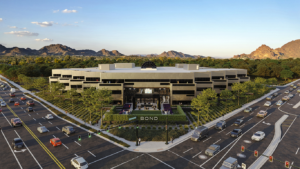There’s nothing quite like one-stop-shopping, where all of your errands can be finished in one trip.
West Valley residents will soon realize the pleasures of one-stop-healthcare, a new development trend, with Dr. John Simon’s latest project: Westgate Healthcare Campus.
The first phase of the 250,000-square-foot, $30 million campus is expected to be finished at the end of the year, with the remainder of the project looking to come online within the next five years.
Once finished, the campus seeks to be a one-stop-shop for anyone’s healthcare needs, hoping to provide everything from lab work and routine check-ups, all the way to dental exams. Simon also hopes to add research components to the campus.
“At the end of the day, it’s the place you can come, and if you have parents, children and yourself, you can all get seen and go about your day,” says Trisha Talbot, managing director for global healthcare services at Newmark Grubb Knight Frank, the marketers for the new development.
Kitchell broke ground for the Glendale project in early March for the first building – a 16,000-square-foot medical office building, which is almost completely leased out, Talbot says.
Healthcare campuses around the country have been creating these types of “medical homes” for a while now, explains Simon, who is also the founder of SimonMed Imaging.
“As a provider, we see patients having to go to multiple locations, where they are receiving disjointed care.” he says. “So from the provider perspective, it’s ideal if you have the whole community in one place.”
Arizona, and particularly the West Valley, don’t have integrated campuses that have been designed from scratch, Simon says.
The Westgate Healthcare Campus will have five buildings in total, designed with a central hub and buildings surrounding the centerpiece, according to Simon.
The campus’ second building is a 13,000 square-foot structure slated for completion in 2017. It is being offered as a medical office building or build-to-suit.
There will also be two 90,000-square-foot medical office buildings, one of which is pre-leasing, followed by a 30,000-square-foot build-to-suit building, or medical office.
Location, location, location
Sixteen years ago, the Westgate area wasn’t much more than dirt fields and roads. But the area has exploded with growth since the construction of the Gila River Arena and eventually the University of Phoenix Stadium, along with the rest of what is now known as the Westgate Entertainment District.
Now, the area is turning into a healthcare hub. The Westgate Healthcare Campus is being built near the Loop 101 Freeway on 99th and Glendale avenues, near the 24-bed St. Joseph’s Medical Center. The new healthcare campus hopes to leverage the existing healthcare infrastructure in the area by adding complementary healthcare services.
“We were very excited to find this parcel,” Simon explains. Its close proximity to the freeway will make it easy for nearly anyone in the Valley to reach, he says.
And the fact it’s so close to three different hospital systems – Dignity Health, Banner Health and the Abrazo Community Health Network – helps provide a solid healthcare infrastructure.
The Westgate area has grown into a centralized hub for healthcare and Simon’s project is just one of many upcoming medical projects in the area, says Brian Friedman, director of economic development for the City of Glendale.
Healthcare has been one of the industries the City of Glendale has been focused on bringing in to boost the economy, Friedman says. The city, especially the Westgate region, has experienced an explosion of growth with projects such as Midwestern University’s Glendale Campus and a medical office tower Rendina Healthcare is developing for St. Joseph’s.
With so many healthcare facilities and options near Glendale’s portion of Loop 101, there are plans to brand the area as a healthcare hub, similar to the City of Scottsdale’s Cure Corridor.
Folks are already used to driving out to the Westgate area for their dining and entertainment needs, Talbot mentions. Now, they can travel there for their healthcare needs as well, she adds.
The Westgate Healthcare Campus is hoping to fill the space with complimentary healthcare providers who will be drawn to the surrounding area.
For the 30,000 square-foot building on the Westgate Healthcare Campus, developers hope to fill the space with a skilled nursing facility, or rehabilitation clinic to complement St. Joseph’s right next door, as well as other hospitals along the Loop 101 freeway, Talbot says.
Bring in the research
Since the St. Joseph’s facility is an acute care facility, finding healthcare services for folks who may not be able to stay at the hospital longer, but want longer-term care, would be a great addition to the area, she explains.
Sometimes, building a healthcare campus near a hospital can impose restrictions on who can lease out the available spaces, but that isn’t the case with this development.
There aren’t any ground-lease or hospital imposed restrictions on this project either, Talbot says. Hospitals can have a right of refusal to certain types of healthcare services if they ground-lease the land around the hospital to another developer.
If hospitals do impose restrictions on services they already offer, it’s so folks won’t go across the street for services the hospital already provides.
But there aren’t any restrictions on the Westgate Healthcare Campus, making it available for everyone.
Medical research facilities and clinics living side by side on the same campus is a common occurrence across the country.
Houston’s Texas Medical Center, one of the largest healthcare campuses in the world, has a mix of eight academic and research institutions and 21 hospitals among many other organizations on its campus.
Due to Arizona’s past rapid growth, many services — including research institutes — are scattered across the Valley, Simon explains.
With the Westgate Healthcare Campus being so close to local hospitals, it only made sense to want to make the campus desirable for research institutes.
“There’s a lot of synergy” having a research institute so close to other hospitals, Simon says. “If you look at any major medical center in the U.S., there’s always clinical and research side by side.”
New campus, modern healthcare
Over the last decade, a healthcare practice’s needs within a space have changed significantly. Electronic medical records have freed up a lot of space within medical offices as doctors no longer need to keep physical copies of their patients’ records.
But retrofitting rooms that were once used as old storage rooms for hundreds of folders filled with medical information and turning them into exam rooms can be pricey. That’s why many practices have been moving into newly built spaces.
Doctors are starting to consolidate and are moving into new spaces because of electronic medical records. And the days of a doctor having a large corner office are long gone too, as doctors spend more time interacting with patients.
Talbot says the Westgate Healthcare Campus meets all of those modern medical needs for practices that are looking to leave their old spaces. The buildings are designed by Butler Design Group and will fit modern tastes while still being practical, Talbot says.
This has been a trend for many new healthcare developments in the Valley.
Older medical offices that can’t meet these modern needs tend to struggle, says Jason Anzalone, vice president of development at Irgens Development Partners.
Obsolete facilities that don’t renovate have been seeing their tenants move to newer or renovated facilities, Anzalone says. But places that do modernize with renovations see success, he adds.
A need for more access to patients, growing practices and new technologies have been driving medical groups to new spaces, Anzalone says.
Growing medical practices from consolidations means medical groups are less fragmented than they were in the past, Anzalone says. Since medical groups offer more comprehensive care than in the past, the groups need large spaces that offer plenty of services. Anzalone’s latest project, a 60,000 square-foot build-to-suit medical facility for Cigna in Peoria, will provide the staff with on-site amenities such as an on-site retail space.
Plaza Companies’ Estrella Medical Plaza II, which will break ground this Fall near the growing Banner Estrella Campus, hopes to fulfill these changing tastes, too.
Sharon Harper, president and CEO at Plaza Companies, says the large physician groups that operate in the Valley want larger floor plans for their new spaces.
They also want to make sure there are retail spaces along with other amentities for the tenants.
The floor plates at the upcoming four-story medical office will be 15,000 square feet, allowing larger users to operate on the same floor, she says.
“They’ve been needing larger spaces because of consolidations and as a result of healthcare providers acquiring practices,” Harper explains. “It’s a pretty significant trend over the last couple of years.”
But Metro Phoenix isn’t the only Arizona hot spot for healthcare. Barbi Reuter, chief operating officer for Cushman and Wakefield, PICOR, says the medical office market is one sector where Tucson is seeing the most growth and opportunity. Tucson Medical Center and Banner-University Medical Center both plan to expand with construction of new facilities on opposite sides of Tucson to provide medical services and offices for physicians.
TMC will construct a 40,000 square foot medical building at Houghton Road and Drexel Road to meet under served healthcare needs on the southeast side of town. Banner-UMC, one of the nation’s top academic medical centers, will build a nine-story patient tower at its current location north of the University of Arizona’s campus.



